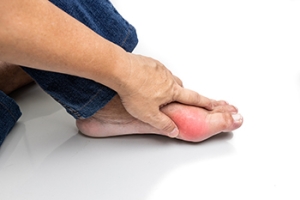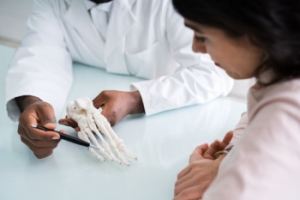
Understanding and Relieving Ingrown Toenails
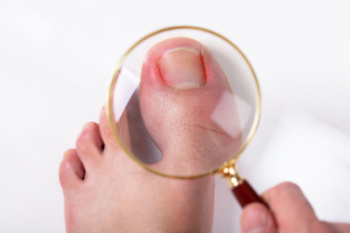
Ingrown toenails account for a significant portion of foot problems, accounting for approximately 20 percent of cases. This condition occurs when the edge of a toenail grows into the surrounding skin, causing pain, swelling, and sometimes infection. Common causes include improper nail trimming, wearing tight shoes, and genetic predisposition. Relief techniques focus on reducing discomfort and preventing further issues. Soaking the affected foot in warm, soapy water can soften the skin and nails, providing temporary relief. Wearing properly fitting shoes with ample toe room and trimming nails straight across, rather than in a curved shape, may help to prevent ingrown toenails. If you have developed this condition, it is strongly suggested that you visit a podiatrist who can successfully treat ingrown toenails, which may include minor surgery for removal.
Ingrown toenails can become painful if they are not treated properly. For more information about ingrown toenails, contact Richard DiBacco, DPM of Podiatry Associates of Erie, Inc.. Our doctor can provide the care you need to keep you pain-free and on your feet.
Ingrown Toenails
Ingrown toenails occur when a toenail grows sideways into the bed of the nail, causing pain, swelling, and possibly infection.
Causes
- Bacterial infections
- Improper nail cutting such as cutting it too short or not straight across
- Trauma to the toe, such as stubbing, which causes the nail to grow back irregularly
- Ill-fitting shoes that bunch the toes too close together
- Genetic predisposition
Prevention
Because ingrown toenails are not something found outside of shoe-wearing cultures, going barefoot as often as possible will decrease the likeliness of developing ingrown toenails. Wearing proper fitting shoes and using proper cutting techniques will also help decrease your risk of developing ingrown toenails.
Treatment
Ingrown toenails are a very treatable foot condition. In minor cases, soaking the affected area in salt or antibacterial soaps will not only help with the ingrown nail itself, but also help prevent any infections from occurring. In more severe cases, surgery is an option. In either case, speaking to your podiatrist about this condition will help you get a better understanding of specific treatment options that are right for you.
If you have any questions please feel free to contact one of our offices located in Erie and Meadville, PA, . We offer the newest diagnostic and treatment technologies for all your foot and ankle needs.
Ingrown Toenail Care
An ingrown toenail is a toenail that grows sideways into the nail bed, causing pain and swelling. Ingrown toenails can worsen and cause drainage, turning into a serious infection.
Several factors affect whether a person is at risk from an ingrown toenail. The many causes include being overweight, diabetes, participating in sports, having a fungal infection of the toe, and cutting your nails too short. Ingrown toenails also have a genetic predisposition, causing some people to be more prone to receive the condition than others. Other causes include improperly fitting shoes and shoes that keep the feet damp.
Ingrown toenails can be preventable with certain measures. For starters, allowing your toe nails to grow slightly longer in length will help prevent them from becoming ingrown. If you have already developed an ingrown toenail, soak the affected toe in warm water. This will alleviate the pain and help prevent an infection from forming. Antibiotic soap or Epsom salts may be added to further help the relieving process and avoid infection. Placing cotton beneath the affected area is also suggested, as this may help the toenail grow upwards and not into the nail bed. Swelling and redness can be reduced by resting with your feet elevated.
A podiatrist should be seen if the pain becomes so serious that it prevents you from doing your everyday activities. If a red streak running up your leg appears or if you suspect your infection has spread, contact a podiatrist immediately. Fast treatments can be undertaken to lessen your pain and have you walking comfortably.
An ingrown toenail can be easily treated with a Band-Aid. Simply wrap the affected toe with a Band-Aid to prevent infection and keep the nail from growing out at a painful angle.
In more serious cases, your podiatrist may decide to make a small incision to remove a portion of your toenail. To prevent the nail from growing back, medication will be placed directly into the nail bed. This procedure would be performed under local anesthesia and is a faster method to alleviate discomfort from an ingrown toenail. Post-procedure directions will have you stay off the affected foot for a day. Afterwards, normal activities can be resumed.
Dealing With Morton’s Neuroma
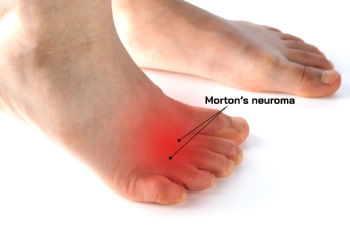 Morton's neuroma is a painful condition that affects the ball of your foot, usually between the third and fourth toes. This common issue is caused by the thickening of the tissue around one of the nerves leading to your toes. Thickening often occurs from excessive pressure or irritation from wearing tight or high-heeled shoes. Activities that involve repetitive foot stress, like running or certain sports, can also advance the development of Morton's neuroma. Morton's neuroma can significantly impact your ability to walk comfortably. As the tissue around the nerve thickens, it causes sharp, burning pain in the ball of your foot, which can make each step excruciating. The pain often spreads into your toes, causing numbness or a tingling feeling. Over time, walking or even standing for a long time can become hard, making it tough to complete daily activities and move around normally. The discomfort can also cause you to alter your walking pattern to avoid putting pressure on the painful area. This might lead to additional problems in areas such as the knee, hip, or back due to the uneven balance of weight. If you are struggling with Morton’s neuroma, it is highly suggested you consult with a podiatrist for an exam and diagnosis, followed by treatment options.
Morton's neuroma is a painful condition that affects the ball of your foot, usually between the third and fourth toes. This common issue is caused by the thickening of the tissue around one of the nerves leading to your toes. Thickening often occurs from excessive pressure or irritation from wearing tight or high-heeled shoes. Activities that involve repetitive foot stress, like running or certain sports, can also advance the development of Morton's neuroma. Morton's neuroma can significantly impact your ability to walk comfortably. As the tissue around the nerve thickens, it causes sharp, burning pain in the ball of your foot, which can make each step excruciating. The pain often spreads into your toes, causing numbness or a tingling feeling. Over time, walking or even standing for a long time can become hard, making it tough to complete daily activities and move around normally. The discomfort can also cause you to alter your walking pattern to avoid putting pressure on the painful area. This might lead to additional problems in areas such as the knee, hip, or back due to the uneven balance of weight. If you are struggling with Morton’s neuroma, it is highly suggested you consult with a podiatrist for an exam and diagnosis, followed by treatment options.
Morton’s neuroma is a very uncomfortable condition to live with. If you think you have Morton’s neuroma, contact Richard DiBacco, DPM of Podiatry Associates of Erie, Inc.. Our doctor will attend to all of your foot care needs and answer any of your related questions.
Morton’s Neuroma
Morton's neuroma is a painful foot condition that commonly affects the areas between the second and third or third and fourth toe, although other areas of the foot are also susceptible. Morton’s neuroma is caused by an inflamed nerve in the foot that is being squeezed and aggravated by surrounding bones.
What Increases the Chances of Having Morton’s Neuroma?
- Ill-fitting high heels or shoes that add pressure to the toe or foot
- Jogging, running or any sport that involves constant impact to the foot
- Flat feet, bunions, and any other foot deformities
Morton’s neuroma is a very treatable condition. Orthotics and shoe inserts can often be used to alleviate the pain on the forefront of the feet. In more severe cases, corticosteroids can also be prescribed. In order to figure out the best treatment for your neuroma, it’s recommended to seek the care of a podiatrist who can diagnose your condition and provide different treatment options.
If you have any questions, please feel free to contact one of our offices located in Erie and Meadville, PA, . We offer the newest diagnostic and treatment technologies for all your foot care needs.
Morton's Neuroma
A neuroma is a thickening of nerve tissue and can develop throughout the body. In the foot, the most common neuroma is a Morton’s neuroma; this typically forms between the third and fourth toes. The thickening of the nerve is typically caused by compression and irritation of the nerve; this thickening can in turn cause enlargement and, in some cases, nerve damage.
Neuromas can be caused by anything that causes compression or irritation of the nerve. A common cause is wearing shoes with tapered toe boxes or high heels that force the toes into the toe boxes. Physical activities that involve repeated pressure to the foot, such as running or basketball, can also create neuromas. Those with foot deformities, such as bunions, hammertoes, or flatfeet, are more likely to develop the condition.
Symptoms of Morton’s neuroma include tingling, burning, numbness, pain, and the feeling that either something is inside the ball of the foot or that something in one’s shoe or sock is bunched up. Symptoms typically begin gradually and can even go away temporarily by removing one’s shoes or massaging the foot. An increase in the intensity of symptoms correlates with the increasing growth of the neuroma.
Treatment for Morton’s neuroma can vary between patients and the severity of the condition. For mild to moderate cases, padding, icing, orthotics, activity modifications, shoe modifications, medications, and injection therapy may be suggested or prescribed. Patients who have not responded successfully to less invasive treatments may require surgery to properly treat their condition. The severity of your condition will determine the procedure performed and the length of recovery afterwards.
Gout's Impact on Foot Health
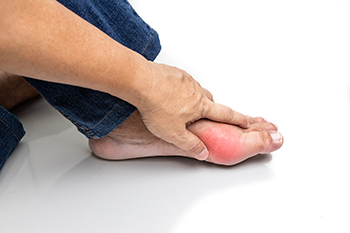
Gout, a form of inflammatory arthritis, can wreak havoc on foot health, causing intense pain, swelling, and stiffness. It often impacts the big toe first. It occurs when uric acid levels in the blood rise, leading to the formation of sharp urate crystals in the joints, often targeting the big toe joint. These crystals trigger sudden and severe bouts of pain, known as gout attacks, which can make walking and even wearing shoes unbearable. Managing gout involves dietary changes to help control uric acid levels. Foods rich in purines, such as red meat, organ meats, and shellfish, should be limited, as they can exacerbate gout symptoms. Conversely, incorporating plenty of fruits, vegetables, whole grains, and low-fat dairy products into the diet can help lower uric acid levels and reduce the frequency and severity of gout attacks. Staying hydrated by drinking plenty of water is also vital for flushing out uric acid from the body. If you have pain in your big toe and surrounding areas, it is suggested that you consult a podiatrist who can diagnose, treat, and offer additional nutritional tips to manage gout.
Gout is a foot condition that requires certain treatment and care. If you are seeking treatment, contact Richard DiBacco, DPM from Podiatry Associates of Erie, Inc.. Our doctor will treat your foot and ankle needs.
What Is Gout?
Gout is a type of arthritis caused by a buildup of uric acid in the bloodstream. It often develops in the foot, especially the big toe area, although it can manifest in other parts of the body as well. Gout can make walking and standing very painful and is especially common in diabetics and the obese.
People typically get gout because of a poor diet. Genetic predisposition is also a factor. The children of parents who have had gout frequently have a chance of developing it themselves.
Gout can easily be identified by redness and inflammation of the big toe and the surrounding areas of the foot. Other symptoms include extreme fatigue, joint pain, and running high fevers. Sometimes corticosteroid drugs can be prescribed to treat gout, but the best way to combat this disease is to get more exercise and eat a better diet.
If you have any questions please feel free to contact one of our offices located in Erie and Meadville, PA, . We offer the newest diagnostic and treatment technologies for all your foot and ankle needs.
Everything You Need to Know About Gout
Gout, typically found in diabetic patients, is an unusually painful form of arthritis caused by elevated levels of uric acid in the bloodstream. The condition typically strikes the big joint on the big toe. It has also been known to strike the knees, elbows, fingers, ankles and wrists—generally anywhere that has a functioning, moving joint.
The high level of uric acid in a person’s bloodstream creates the condition known as hyperuricema—the main cause of gout. Genetic predisposition occurs in nine out of ten sufferers. The children of parents who suffer gout will have a two in ten chance of developing the condition as well.
This form of arthritis, being particularly painful, is the leftover uric acid crystallizing in the blood stream. The crystallized uric acid then travels to the space between joints where they rub, causing friction when the patient moves. Symptoms include: pain, redness, swelling, and inflammation. Additional side effects may include fatigue and fever, although reports of these effects are very rare. Some patients have reported that pain may intensify when the temperature drops, such as when you sleep.
Most cases of gout are easily diagnosed by a podiatrist’s assessment of the various symptoms. Defined tests can also be performed. A blood test to detect elevated levels of uric acid is often used as well as an x-ray to diagnose visible and chronic gout.
Treatment for gout simply means eliminating symptoms. Non-steroid anti-inflammatory drugs or NSAIDs (Colchicine and other corticosteroid drugs, etc.) will quell the redness, the swelling, and the inflammation. However, managing your diet, lifestyle changes, and using preventative drugs are all helpful toward fully combating the most severe cases.
Those that lead an inactive lifestyle are at a higher risk for gout. Any amount of exercise decreases the probability of repeat encounters with the condition. Reducing your consumption of red meat, sea food, and fructose-sweetened drinks also reduces the likelihood of chronic gout as well.
Ingesting Vitamin C, coffee, and particular dairy products can help with maintaining a healthy lifestyle. There are new drugs out on the market that inhibit the body’s production of uric acid-producing enzymes. However, reducing or eliminating your overall levels of uric acid is the best remedy to ensuring you lead a gout-free life.
Understanding Ankle Sprains and Strains

Ankle sprains and strains are injuries that can significantly impact your mobility and daily activities. A sprain occurs when the ligaments, which are the tough bands of tissue connecting bones at the ankle joint, are abnormally stretched or torn. Conversely, a strain involves similar damage but affects muscles or tendons, which are the tissues that connect muscles to ankle bones. These injuries can result from repetitive motions or a sudden incident, like a twist or fall. Diagnosis by a podiatrist typically involves a medical history review and physical examination, and may include imaging tests, such as X-rays, CT scans, or MRIs. While most sprains and strains heal over time with rest, bracing, and anti-inflammatory medications, more severe cases may require surgery for a full recovery. It is important to manage these injuries properly to prevent chronic pain or instability. If you experience an ankle sprain or strain, it is suggested that you contact a podiatrist who can provide an accurate diagnosis, tailored treatment plan, and guidance on rehabilitation exercises.
Although ankle sprains are common, they aren’t always minor injuries. If you need your ankle injury looked at, contact Richard DiBacco, DPM from Podiatry Associates of Erie, Inc.. Our doctor can provide the care you need to keep you pain-free and on your feet.
How Does an Ankle Sprain Occur?
Ankle sprains are the result of a tear in the ligaments within the ankle. These injuries may happen when you make a rapid shifting movement while your foot is planted. A less common way to sprain your ankle is when your ankle rolls inward while your foot turns outward.
What Are the Symptoms?
- Pain at the sight of the tear
- Bruising/Swelling
- Ankle area is tender to touch
- In severe cases, may hear/feel something tear
- Skin discoloration
Preventing a Sprain
- Wearing appropriate shoes for the occasion
- Stretching before exercises and sports
- Knowing your limits
Treatment of a Sprain
In many cases, the RICE method (Rest, Ice, Compression, and Elevate) is used to treat ankle sprains. However, you should see a podiatrist to see which treatment option would work best with your injury. In severe cases, surgery may be required.
It is important to ask your doctor about rehab options after you receive treatment for your injury. Stretching, strength training, and balance exercises may help the ankle heal while also preventing further injury.
If you have any questions, please feel free to contact one of our offices located in Erie and Meadville, PA, . We offer the newest diagnostic and treatment technologies for all your foot care needs.
Ankle Sprains
Ankle sprains occur when ligaments that support the ankle stretch beyond their limits and tear. These types of injuries are very common and can occur in people of all ages. Sprains may range from mild to severe, depending on how much damage is done to the ligaments. If a sprain goes untreated, a more severe sprain may occur which can further damage the ankle. Repeated ankle sprains can lead to chronic ankle pain.
There are some risk factors that can increase your risk of suffering a sprained ankle. Those who participate in sports, walk on uneven surfaces, have a prior ankle injury, are in poor physical condition, or wear improper shoes are more likely to get a sprained ankle.
There are a few symptoms to look out for if you suspect you are suffering from a sprained ankle. Some common symptoms are swelling, bruising, tenderness, and instability of the ankle. In cases where the tearing of the ligaments is severe, there may be a “popping” sound when the strain occurs.
The RICE method is proven to be effective in treating ankle sprains. RICE stands for Rest, Ice, Compression, and Elevation. Rest is important for treatment, especially within the first 24 to 48 hours. You should also ice your sprained ankle for the first 48 hours for 20 minutes at a time. A small piece of cloth should be placed between the ice and the affected area. For the compression step, you should wear a brace that is snug, but not too tight that it cuts off circulation. When choosing a brace, be sure to choose one that is suitable for the type of ankle sprain you have. Lastly, you should elevate your foot above the heart as often as possible.
After you treat a sprain, you should go through rehabilitation to prevent the injury from occurring again. There are three phases to the rehab process. The first phase involves resting, protecting, and reducing the swelling of the injury. The second phase consists of restoring the ankle’s flexibility, range of motion, and strength. The third phase consists of slowly returning to activity and maintenance exercises.
If you suspect you have an ankle sprain, you shouldn’t hesitate to consult with your podiatrist. Your podiatrist will be able to give you a proper diagnosis and a suitable treatment option for your condition.
What Does a Podiatrist Do?
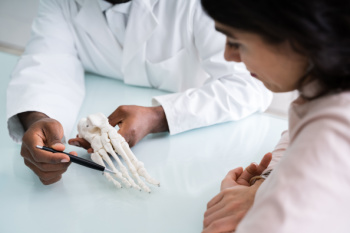
Podiatrists are medical professionals specializing in diagnosing, treating, and preventing foot and ankle disorders. Their expertise covers a wide range of conditions, including bunions, heel pain, ingrown toenails, sports injuries, and diabetic foot care. Podiatrists play an important role in maintaining mobility and overall health, particularly for individuals with chronic illnesses or those engaged in physical activities. To become a podiatrist, one must complete a Doctor of Podiatric Medicine, or DPM, degree, which involves four years of specialized medical education following a bachelor's degree. This training includes courses in anatomy, physiology, pharmacology, and pathology, as well as clinical rotations. After obtaining their degree, podiatrists must complete a residency program, usually lasting three years, to gain hands-on experience in various settings. Podiatrists can help people by providing tailored treatments, such as orthotics, medications, and surgical interventions, to alleviate pain and improve function. Regular visits to a podiatrist can prevent minor issues from becoming major problems. If you are in need of foot or ankle care, it is suggested that you seek guidance and treatment from this type of doctor.
If you are dealing with pain in your feet and ankles, you may want to seek help from a podiatrist. Feel free to contact Richard DiBacco, DPM from Podiatry Associates of Erie, Inc.. Our doctor can provide the care you need to keep you pain-free and on your feet.
What Is a Podiatrist?
A podiatrist is a doctor of podiatric medicine who diagnoses and treats conditions of the foot, ankle, and related structures of the leg. Your podiatrist may specialize in a certain field such as sports medicine, wound care, pediatrics, and diabetic care. Podiatrists have the ability to become board certified through training, clinical experience, and then taking an exam.
What Do Podiatrists Do?
On a daily basis, a podiatrist may perform the following activities:
- Diagnose foot ailments such as ulcers, tumors, fractures, etc.
- Use innovative methods to treat conditions
- Use corrective orthotics, casts, and strappings to correct deformities
- Correct walking patterns and balance
- Provide individual consultations to patients
It is very important that you take care of your feet. It’s easy to take having healthy feet for granted, however foot problems tend to be among the most common health conditions. Podiatrists can help diagnose and treat a variety of feet related conditions, so it is crucial that you visit one if you need assistance.
If you have any questions please feel free to contact one of our offices located in Erie and Meadville, PA, . We offer the newest diagnostic and treatment technologies for all your foot and ankle needs.





